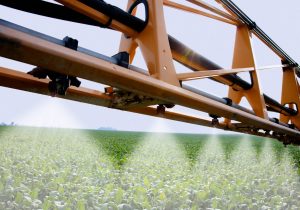Beneficial insects and pest management
By Dusty Sonnenberg, CCA, Ohio Field Leader: a project of the Ohio Soybean Council and soybean checkoff.
Scouting a developing crop is an important part of an integrated pest management (IPM) strategy. Sometimes an area not considered is the impact of beneficial insects. Dr. Curtis Young discussed important factors to consider when controlling pests at the 2020 Conservation Tillage Conference. “Not all arthropod organisms (insects) are pests. There are beneficial insects, spiders, predatory mites, bacteria, viruses, fungi, and nematodes,” said Young. “Each of these has a role in managing and suppressing pest populations in the field.”

Beneficial insects play many key roles in crop production. Pollination is an important function; pest control is another. “There are insects, spiders, mites and others that eat the harmful insects. These are often referred to as biological control agents. They include predators, parasitoids and parasites,” said Young. “They are useful at suppressing pest species populations like aphids, mites, and scale insects.”
Agronomic management decisions typically involve establishing and evaluating various thresholds. This is true when evaluating the need for treatment based on pest threshold levels. There are both economic and agronomic thresholds to consider. It is important to realize that a predator insect will not totally eradicate a pest insect. “If a predator eliminates their food resource (pest insect), they will eliminate themselves at the same time,” said Young. “A good predator will suppress the pest insect population. A farmer will have to accept some level of a pest population being present. The hope is that they will hold the pest population below a threshold that we can tolerate.”
Beneficial organisms are biological organisms just like the pest organisms they are feeding on. “Biological organisms have specific requirements and an optimum range for growth, development and survival,” said Young. “Farmers need to understand what the optimum requirements are so that they can be maintained or augmented to support the beneficial biological organisms, or else they will leave when their resources (pest organisms as a food source) are low.”
Beneficial organisms require a stable environment to survive. “This stable environment is not always maintained in agriculture,” said Young. “Biological organisms simply react to their environment and will protect themselves. They are very opportunistic. Farmers may need to provide beneficials with alternative food sources, or the beneficial insects will switch to another food source that may not benefit farmers. It may be the larvae stage that is predatory, and the adult stage that needs a very high energy source of food, such as nectar or pollen. That may require a farmer to incorporate having patches of diverse desirable plants around the farm to encourage and sustain the adult beneficial organisms so they are present when needed.” Farmers should also carefully consider their use of pesticides in the field, as many will kill both the beneficials and pest insects.
Environmental stability is important to establishing and maintaining beneficial organisms. They are very susceptible to environmental disturbances and disruptions. “Environmental disruptions can include crop harvest, especially if there are no cover crops present. Mono-cropping and limited plant diversity can cause disruptions, as well as plowing and  cultivation. Pesticide application beyond insecticide application can negatively impact beneficials. Insecticides cause obvious direct injury. Many fungicides have insecticidal properties that negatively impact beneficials. Herbicides cause a reduction in plant diversity which may harm beneficials as it reduces habitat and alternative food sources,” said Young.
cultivation. Pesticide application beyond insecticide application can negatively impact beneficials. Insecticides cause obvious direct injury. Many fungicides have insecticidal properties that negatively impact beneficials. Herbicides cause a reduction in plant diversity which may harm beneficials as it reduces habitat and alternative food sources,” said Young.
Ideally beneficials would arrive at the same time as a pest, and initiate control immediately. In reality there is often a lag time between when the pest population increases, and the beneficials arrive. Ideally there would be a beneficial predator for every pest. This is also not the case. “Fortunately, many beneficials are generalists and will switch from one pest to another whenever it is easier to find. Unfortunately, the beneficials do not discriminate between the good and bad insects, and they may actually feed on the good insects,” said Young.
There are many beneficial insects in the various Orders. Beetles are in the Coleoptera order. Wasps, Bees, and Ants are in the Hymenoptera Order; Flies are Diptera; and True Bugs are Hemipetra. Earwigs fall in the Dermaptera order. It is useful to be able to identify beneficial organisms in all the life stages. Metamorphosis is the process of going from the immature stage of an organism to a mature form. Those organisms that undergo incomplete metamorphosis go through three stages, which include egg, nymph and adult. Those that undergo complete metamorphosis undergo four stages which include egg, larva, pupa and adult. Having a working knowledge of the types and life stages of both beneficial and pest insects will allow farmers to make informed management decisions as they scout the fields and evaluate treatment options based on threshold pressures and the presence and development of both types of insects.